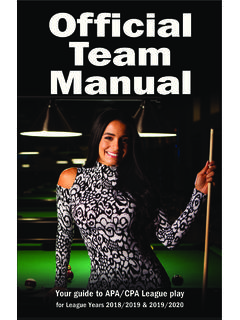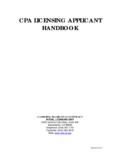Transcription of 2020 Rules Booklet - American Poolplayers Association
1 A1 Revised 1/20 CONTENTSG eneral Description ..1 Lagging ..2 Racking ..3 Breaking ..4 After The Break ..6 Shooting The Wrong Balls ..8 Combination Shots ..9 Pocketed Balls ..10 Balls On The Floor ..10 Accidentally Moved Balls ..11 Close Hits ..12 One Foot On The Floor ..13 Marking The Table ..14 Stalemates ..14 Frozen Balls ..15 Fouls ..17 How To Win A Game ..20 Copyright 2020, American Poolplayers Association , RULESGENERAL DESCRIPTIONIt is impossible to cover every situation with Rules . Common sense must prevail. Play within the Spirit of the Rules , as well as the written rule . Teams that try to gain an advantage by creating their own interpretation of Rules are subject to sportsmanship violations.
2 Win at the table and not from the is played with a cue ball and a rack of 15 object balls . The primary purpose of this game is for one player to pocket the solid balls numbered from 1 to 7 or the striped balls numbered from 9 to 15, and then pocket the 8-ball before their opponent . Each player s category of balls is determined when the first player legally pockets a ball . For example, if the first ball pocketed in the game is the 3-ball, then that player must pocket the rest of the balls numbered 1 to 7 while the opposing player attempts to pocket all the balls numbered 9 to 15 . The turn passes from one player to the next whenever the shooter fails to pocket a ball of their category or fouls.
3 A player legally pocketing a ball of their category must continue to shoot .The player who pockets their entire category of balls first, and then legally pockets the 8-ball, is the winner of the game . In League play, the 8-ball must be pocketed in a marked pocket .NOTE: In Masters Divisions, players have the option of calling, rather than marking, the 8-ball pocket .29-Ball is played with a cue ball and nine object balls numbered 1 through 9 . It is a rotation game, meaning the balls are shot in numerical order . The shooter must strike the cue ball into the lowest numbered ball on the table first . The game is over when the 9-ball is legally pocketed.
4 A player retains their turn at the table as long as they strike the lowest numbered ball first, and legally pocket a ball . The shooter need not pocket the lowest numbered ball to continue shooting . For example, the shooter may strike the 1-ball into the 4-ball (a combination shot) thus pocketing the 4-ball and continue their turn at the table . On their next shot, the 1-ball must again be struck first . If the shooter shoots the lowest numbered ball into the 9-ball and pockets the 9-ball, the game is over . In League play, balls 1 through 8 are worth one point each when pocketed and the 9-ball is worth two points.
5 NOTE: In Masters Divisions, 9-Ball is not played by ball count/points . Each individual game is won when the shooter legally pockets the 9-ball . 1. L AGGINGP layers lag at approximately the same time to see who wins the first break . The ball that stops closest to the head rail wins . It is permissible to strike the head rail . If the lagged balls make contact with each other, both players fail to strike the foot rail during the lag, or a ball stops in the jaw of a pocket, re-lag . Failure to strike the foot rail, or striking a side rail, or any 3pocket, results in loss of lag . Players are discouraged from using the cue ball during the lag.
6 Insisting upon lagging with the cue ball is considered a sportsmanship violation and should be reported to Local League Management . The winner of the lag breaks in the first game; from that point on, the winner of each rack breaks in the next game . Please note the following: In Masters Divisions, the winner of the lag will have choice of format or the break . Once the format has been chosen, the entire set of that format must be completed before moving to the other format . In Doubles Divisions, the lag does not count as part of the player rotation . 2. RACKINGAll balls should be frozen (touching) as tightly as possible.
7 Balls are racked by the non-breaking player, with the head (front) ball on the foot spot . The breaking player may request and receive a rerack . The loser of the lag, and/or the loser of any subsequent game, racks for the opponent . In each format, the ball placement in the rack is as follows: 8-Ball - All 15 balls are racked in a triangle, with the 8-ball in the center . The remaining balls can be placed in any order . 9-Ball - The balls numbered 1 through 9 are racked in a diamond shape . The 1-ball is placed at the front of the diamond, the 9-ball in the 4center . The remaining object balls can be placed in any order.
8 When using coin-operated tables, teams have the option to substitute any unused balls (10-ball to 15-ball) for pocketed balls following a short game; this will save both teams money during League night . The breaker can ask for the lowest available nine balls to be used in each game .Example: If the 3-ball and 9-ball are made on the break (because a 9-on-the-Snap is a win, unless you scratch), you can use the 10-ball and 11-ball in the next rack . The object ball sequence in the next game would be 1, 2, 4, 5, 6, 7, 8, 10 and 11 . The 11-ball, in effect, is the 9-ball (last ball) in this game . Do not use the 10-ball to replace the 3-ball, as this can be confusing.
9 Shoot the balls in numerical order . 3. BREAKINGThe rack must be struck before a foul can occur .A player must break from behind the head string for the break to be considered legal; in addition, at least four object balls must be driven to the rails or a ball must be pocketed . The cue ball may not be shot into a rail before hitting the rack .NOTE: A player who is physically unable to break due to a medical condition may pass the break to the opponent, but only with prior approval from Local League Management . Such occurrences 5should be marked as a Defensive Shot and an inning where appropriate . Players are not allowed to have a teammate break for them.
10 The cue ball s point of contact with the table is used to determine if it is behind the head string, also referred to as being in . To make this determination simply compare the head string, an imaginary line connecting the two diamonds that are second from the head rail, to the cue ball s point of contact . A ball that is dead-center on the head string is considered out, or not behind the head string .The cue ball must make contact with the rack as follows to be considered legal: 8-Ball - The head ball or the second row of balls must be struck first . Failure to strike the head ball or second row of balls does not result in a foul.



